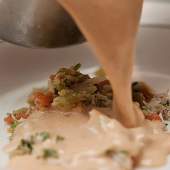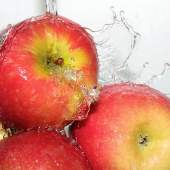Iceland

Heat. High humidity. Sunburn and sand between your toes. Deep-fried everything. Yes, those dog days of summer are upon us again.
So perhaps it would be a good time for a refreshing change of pace — a journey to someplace far away, invigorating, and entirely different. Someplace like…
…Iceland.
A relatively young country as landmasses go (Iceland didn’t become an independent republic until 1944), this island off the southeast coast of Greenland is slightly larger in area than the state of Kentucky with a population about the size of Santa Ana, California. If your idea of heaven is a place where there is an average of just three inhabitants per square mile, where volcanic eruptions are met with a shrug, where the musical stylings of Björk are all the rage, and fresh avian, land, and aquatic foods (especially the latter) are prevalent, Iceland just might be the country for you.
Icelandic cuisine, which in many ways hasn’t changed much since the days of the Vikings, is heavily influenced by its proximity to the Arctic Circle and the age-old necessity of preserving meats harvested in summer to see its denizens through harsh winters. Methods include drying, pickling, fermenting, and smoking, and chefs tend also to subscribe to the “nose to tail” philosophy, another holdover from an earlier time before the advent of modern refrigeration methods.
In the capital city of Reykjavík (where about two-thirds of the population resides), the restaurant scene has been burgeoning of late, with new and exciting options that were unimaginable only 20 years ago. This is celebrated each year in late winter during the annual Food and Fun Festival, when some of the world’s finest chefs travel to Reykjavík to collaborate with local restaurants to demonstrate what is possible using only locally sourced ingredients.
Here are some of them:
- Seafood — Iceland’s island status means, of course, that seafood is a vital part of the local diet. The locals enjoy everything from haddock, herring, cod, shark (only after curing underground for 6-12 weeks, resulting in a taste similar to very, very sharp cheese), salmon, lobster, monkfish, whale (which has been compared in taste and texture to a cross between beef steak and tuna), and lots more. Wind-dried fish is often made into jerky, which is a popular snack sold on the street.
- Hangikjöt (Smoked Lamb) — Sheep farms are everywhere in Iceland, and as a dish, lamb is a perennial favorite. Local tradition dictates that Icelandic livestock gets to graze pretty much anywhere it wants, which is said to account for the lamb meat’s rich flavor. The farmers then smoke the lamb in traditional ways, which include using birch and sometimes dried sheep dung. The finished product is generally served with a béchamel sauce, beets, peas, and potatoes.
-
Pylsur (Hot Dogs) — Lamb is also a main component of these, which also include beef and pork, and they have a rich and distinctive flavor. In and around Reykjavík, pylsur are available at a very popular chain of hot dog stands called Bæjarins Beztu Pylsur (English translation: The Town‘s Best Sausages). The owners like to boast that President Bill Clinton visited once, and acceptable condiments include sweet mustard, onions, remoulade, and yes...ketchup.
Pylsur stand - Puffin — A small seabird that when cooked, has a flavor similar to pastrami. Almost too cute to eat, though.
-
Rúgbrauð — This dark rye bread is crustless and extremely dense. It is served with butter and other toppings including pickled herring. It has a long shelf life, but if it gets stale, it can be made into a bread pudding or porridge. The common nickname for this bread is “brumari,” which means “thunderbread,” as consuming too much of it can cause flatulence. (You’ve been warned.)
Rúgbrauð - Skyr — This sounds too good to be true — a thick, creamy, soft cheese very similar in composition to yogurt, high in protein and calcium but with virtually NO fat. According to Serious Eats, Skyr “has a wonderfully creamy, spoonable texture and tastes somewhere between tart Greek yogurt, crème fraîche, and soft-serve.” It is also marketed as a drink and a dipping sauce. Do Icelanders partake in this all day, every day? You bet — often with blueberries and other fruits mixed in. If you want to do as the Icelanders do, here in the States some specialty grocery stores stock Skyr, including the popular brand Siggi’s.
- Pönnukökur — Pancakes, or the Icelandic incarnation of them. They are very thin like crepes, and served rolled with berries, jam, or cinnamon, with powdered sugar.
- Licorice — Iceland is as crazy about this confection as the rest of Scandinavia — in addition to the traditional black licorice, they also have a salty variety, and chocolate-covered licorice is a great after-dinner treat.
You could wash all of this down with…
- Brennivín — The literal translation of this is “burning wine,” but it is commonly known as “Black Death.” It’s really schnapps, made from caraway and fermented potatoes, and has a real kick. Skål! (Cheers!)
For the past couple of years in late April, Chicago has been among several North American cities hosting a Taste of Iceland Festival, a celebration of the country’s cuisine, cocktails, music, film, and art. Will there be another one in 2018? Stay tuned!





